This was published 8 months ago
There’s much more to Lindy Lee’s Ouroboros than the $14m price tag
By Alex Burchmore
Although only recently unveiled, Lindy Lee’s dazzling new public sculpture Ouroboros at the National Gallery of Australia already feels familiar. This might be due to the video diary of the work’s making, its interstate journey, and its final installation broadcast across the NGA’s socials, including the “high-stakes reality series” Art Truckers now screening on YouTube. Ouroboros will undoubtedly remain a fixture of our social media pages as an eminently Instagrammable addition to the capital’s cultural landscape.
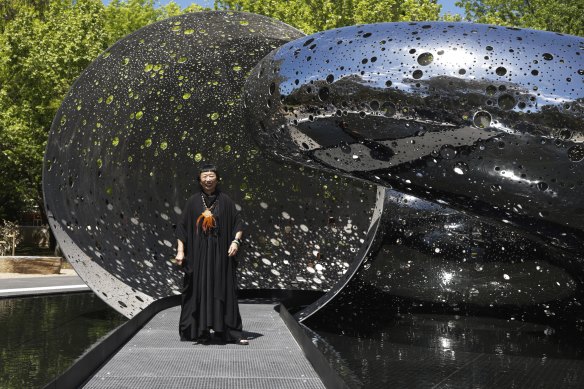
Artist Lindy Lee after the official unveiling of her sculpture Ouroboros in front of the National Gallery of Australia on October 24.Credit: Alex Ellinghausen
An air of familiarity may also be due to the breathless coverage of the work’s $14 million price tag that accompanied director Nick Mitzevich’s announcement of the commission of the most expensive work in the gallery’s history in September 2021.
Critics seem perennially absorbed by the cost of cutting-edge contemporary art, convinced that funds would be better spent elsewhere. The classic case is the acquisition of Jackson Pollock’s Blue Poles by the NGA’s inaugural director James Mollison in 1973 for the then-exceptional sum of $1.3 million. More recently Mitzevich faced criticism over the 2019 purchase of Jordan Wolfson’s $6.67 million robotic performer Body Sculpture.
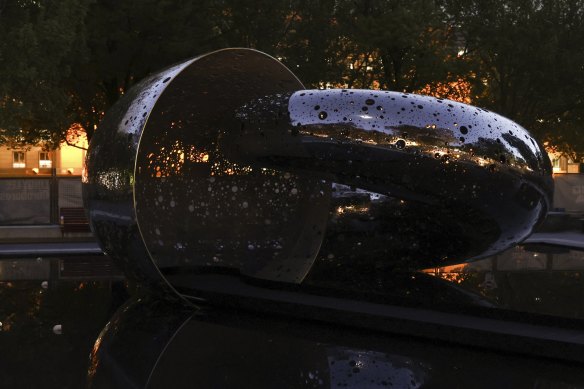
Ouroboros is at its best when seen at night.Credit: Alex Ellinghausen
Cost is certainly a factor when considering the value of a work of art, and transparency is a virtue when public funds are involved. The price of a “blue-chip” work like Blue Poles – which has now appreciated to an eye-watering $500 million – may well reflect the whims of the market. Yet the price tag attached to complex contemporary commissions such as Ouroboros and Body Sculpture is more a reflection of the number of highly skilled technicians involved, the time needed to co-ordinate their talents, and the unavoidable expenses of materials, manufacture and transport.
Rather than holding the work to account for its cost, then, it would perhaps be more generous to consider this a testament to the ingenuity and expertise involved in its making. Any answer to the question of “worth” must also include a recognition of the dividends of a different kind that will accrue. In Ouroboros we have gained an enduring and accessible addition to a shared public space, a monument to the values of creativity and collaboration that deserve to be championed.
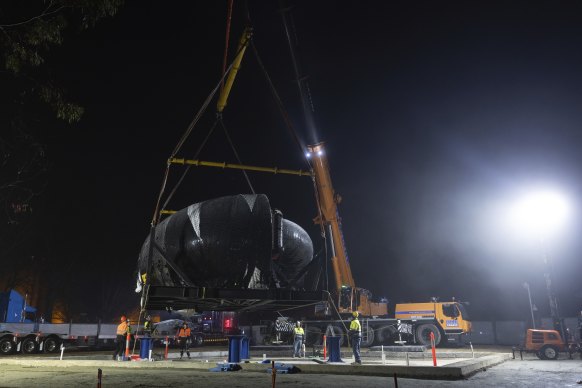
Ouroboros being craned into position at the front of the National Gallery of Australia.Credit: The Sydney Morning Herald
Beyond the bottom line and the headlines it generates, my initial thought on seeing Ouroboros was of the resemblance to Lee’s earlier The Life of Stars, installed at the entrance to the Art Gallery of South Australia (AGSA) in Adelaide in 2018. This, too, was acquired on Mitzevich’s recommendation, marking the end of his eight-year tenure as AGSA’s director. Sydneysiders might also think of Secret World of a Starlight Ember, installed in 2020 at the entrance to the Museum of Contemporary Art to mark the opening of Moon in a Dew Drop, a major retrospective of Lee’s career.
All three are part of an ongoing series of perforated stainless-steel public sculptures that Lee initiated in Shanghai in 2015, subsequently creating works for Zhengzhou, Hainan, Qingdao, Xi’an, Hong Kong and Brisbane, as well as Adelaide, Sydney and Canberra. They are united not only by a shared material, rounded form and elaborately pierced reflective surfaces, but also by their captivating illumination from within. They glimmer and glow like fallen meteorites, mirroring the motion of the world around them during the day, but coming most alive at night.
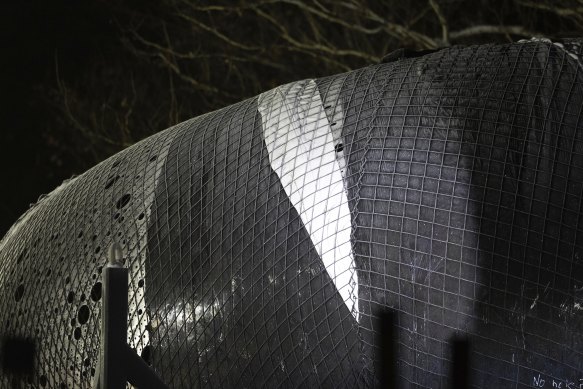
Ouroboros on the back of a truck just before being craned into position.Credit: The Sydney Morning Herald
In addition to its cosmopolitan connections, Ouroboros notably returns an Australian artist to pride of place in the NGA forecourt. Lee’s sculpture replaces New Yorker Barnett Newman’s Broken Obelisk, which took the prime spot as part of the blockbuster show American Masters in 2018.
The two are worlds apart: one an Ozymandian totem against the passage of time, its surface oxidised to an earthy copper-red; the other a celebration of transience and renewal.
Ouroboros sits comfortably, however, alongside James Turrell’s Within Without, the last major commission for the NGA’s Sculpture Garden, installed in 2010. Both seek to activate the threshold space by drawing attention to the otherworldly qualities of light, and inviting a moment of meditative reflection.
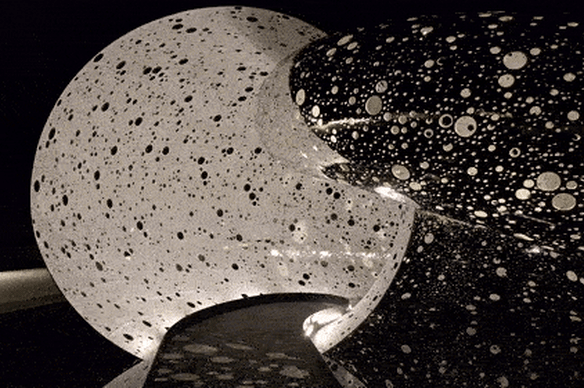
Inside Lindy Lee’s $14m sculpture.Credit: Lindy Lee
Broken Obelisk has found a new home (for the next five years) at Shoalhaven Regional Gallery as part of the federal government’s “Sharing the National Collection” program.
Abundance, a maquette of Ouroboros cast in ABC Bullion Australian gold, will also travel across the country, following its display as an eye-catching point of connection between the larger sculpture and a selection of Lee’s recent work in the NGA’s Lindy Lee exhibition accompanying the installation of the sculpture.
This includes another new installation, Charred Forest, which complements the liquid- and light-filled Ouroboros with a sombre stand of seven blackened camphor trees. These might at first suggest the aftermath of a bushfire, yet their charring is the result of a carefully applied Japanese preservation technique – the localised equivalent of a controlled burn.

Visitors viewing Ouroboros at night.Credit: Alex Ellinghausen
Understood as a companion piece to Ouroboros, which can be read in metaphysical terms as an evocation of the watery cosmic principle of yin, Charred Forest can also be regarded as a manifestation of the fiery principle of yang. Lee’s articulation of the surface of the trees with a constellation of conical perforations, revealing the natural hue of the timber within, further emphasises this parallel, as well as the interconnection of yin and yang in Chinese cosmology.
Lee started to include these subtle nods to her Chinese heritage in her work in the mid-1990s, training as a practitioner of Zen Buddhism and exploring ideas of impermanence and renewal common to Buddhist and Daoist thought.
Such ideas are central also to the five monumental sheets of archival paper, variously marked with fire and rainwater or saturated with ink, and the flung bronze work The Unconditioned, installed facing Charred Forest. As with her Chinese counterparts Cai Guo-Qiang and Xiao Lu, Lee finds inspiration in the themes of elemental metamorphosis and alignment with natural forces at the heart of Chinese aesthetic philosophy. Their allusion to such ideas is elegantly restrained rather than nakedly symbolic. For Lee, especially, this is a personal journey through inherited materials and practices searching for essential truths.
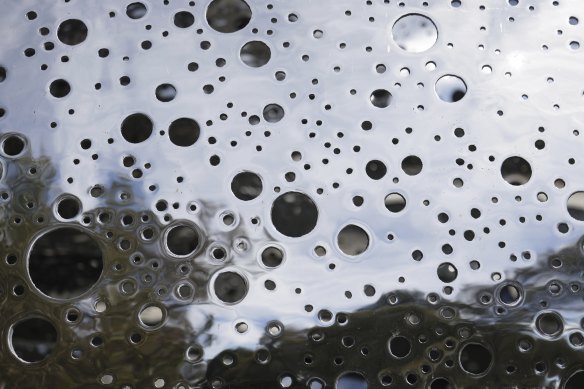
A close up of Ouroboros.Credit: Alex Ellinghausen
The metaphysical is always grounded in Lee’s work in the mundane. In Adelaide, for example, The Life of Stars echoes the iconic “Mall’s Balls” in nearby Rundle Mall. The Spheres, to use their formal title, were created for the city in 1977 by Vienna-born Bert Flugelman, who later graced Canberra with his equally iconic Cones.
There’s a certain poetry here. Flugelman immigrated to Australia in 1938, seeking refuge from the horrors of Nazism, just over a decade before Lee’s parents fled the uncertainty provoked by the founding of the People’s Republic of China. Cones was commissioned to mark the opening of the NGA in 1982, just as Ouroboros celebrates the institution’s 40th anniversary.
Both Lee and Flugelman are highly accomplished artists whose lives and works have become emblematic of the more admirable aspects of Australian character: our embrace of diversity, the sanctuary we extend to those seeking refuge, the opportunities for all to find recognition here, regardless of origin or appearance.
Flugelman’s public sculptures have now become part of the DNA of capital cities across the country, their nicknames a testament to their familiarity. Ouroboros, too, long after the prejudices of the present have passed, will remain a beacon to the better side of human nature. Perhaps even with a catchy nickname.
Lindy Lee is at the National Gallery of Australia until June 1.